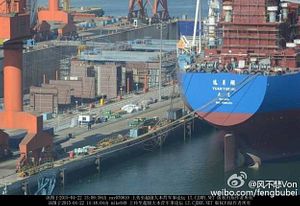China’s first domestically built aircraft carrier, designated 001A-class, is likely to enter sea trials next year and potentially enter service with the People’s Liberation Army-Navy (PLAN) by early 2017, according to multiple reports. The PLAN’s WeChat account, in addition to reports citing Chinese military sources in Japan’s Nikkei Asian Review, suggest that the carrier–currently under construction at a shipyard in Dalian, will launch later this year.
Last year, the Hong Kong-based daily Ming Pao had suggested that China could launch its first domestic carrier in October 2019 to mark the 70th anniversary of the founding of the People’s Republic of China.
Last week, on August 25, Colonel Wu Qian, spokesperson for the Chinese Ministry of National Defense, commented on the carrier’s construction progress. “What I’m authorized to tell you is that the construction of the first domestically-built aircraft carrier is pressing ahead according to plan,” he said, in response to a question from a reporter at a press conference.
Referring to the reporter’s query about the authenticity of “a good-looking picture of the aircraft carrier” that had circulated online, purporting to show a mostly completed arched bow with a ski-jump deck, Wu added that “Our first domestically-built aircraft carrier not only looks impressive, it is also strong and powerful inside.” He did not specify a timetable for the carrier’s launch or commissioning.
In the final days of 2015, China’s Defense Ministry offered its first official confirmation that Beijing was building its first indigenous carrier. Eagle-eyed social media users in China had identified the carrier’s hull construction at the same dry dock that was used to upgrade and refurbish the Liaoning, China’s first-ever carrier, as early as October 2015.
The Liaoning, named for the Chinese province where it was upgraded and refurbished, is a former Soviet Admiral Kuznetsov-class carrier that was in service with the Ukrainian Navy as the Varyag. The carrier was commissioned in 2012, making China the second Asian navy after the Indian Navy to operate an aircraft carrier in excess of 40,000 tons.
Aircraft carriers, beyond their practical applications in allowing for increasingly expeditionary naval deployments, bear an element for prestige. Despite this, China has been fairly reticent in discussing its carrier program, preferring to keep a low profile.
Given growing concerns about China’s increasing naval might around the region, Beijing is reluctant to offer excessive public information about its carrier plans. The U.S. Department of Defense’s 2016 assessment of China’s military capabilities suggested that China “could build multiple aircraft carriers over the next 15 years.”
The Liaoning features a short take-off but arrested recovery (STOBAR) launch system, designed for the Shenyang J-15 multirole fighter, the PLAN’s primary carrier-based fighter. The 001A is likely to replicate this given publicly available imagery of the ski-jump deck.
China’s successive carriers may include more advanced technology, including possibly nuclear propulsion and a more advanced catapult assisted take-off but arrested recovery (CATOBAR) system. Earlier this summer, IHS Jane’s reported that Beijing had started flight testing a nose-wheel modified J-15 for CATOBAR operations. Currently, only the French and U.S. navies feature CATOBAR-equipped carriers.
































